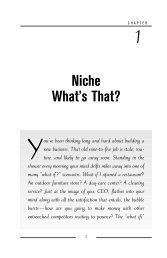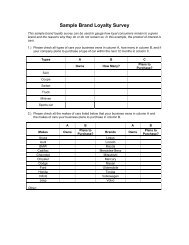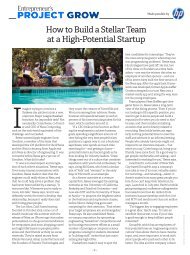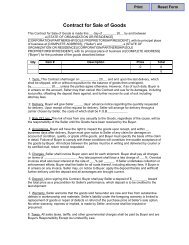Chapter 1 Mail Order Mania
Chapter 1 Mail Order Mania
Chapter 1 Mail Order Mania
Create successful ePaper yourself
Turn your PDF publications into a flip-book with our unique Google optimized e-Paper software.
“Profitability,” he advises, “comes at about the same time, in three to five years. You<br />
want to start breaking even right away, but the real profits come when you have a solid<br />
customer base that buys from you with some frequency. It takes a few years to build up<br />
this base.”<br />
And while success doesn’t come overnight to most, it doesn’t come at all to some. “Only<br />
about 20 percent make it,” cautions Schulte. This isn’t a reason to quit before you start,<br />
but it’s a darn good reason to do your research, plan very carefully, and get everything in<br />
place before you start. That’s why you bought this book!<br />
CRANK-UP COSTS<br />
One of the Catch-22s of being in business for yourself is that you need money to make<br />
money—in other words, you need startup funds. With mail order, you can start off with a<br />
much more manageable investment than your peers in retail or manufacturing. Since you<br />
can start as a one-person show in your own home, you automatically eliminate expenses<br />
like rent and employees. As an added bonus, equipment costs are relatively low; your<br />
major outlays will be for a computer, software, two to three phone lines, a digital camera,<br />
internet access, and a website. This whittles your other initial expenses down to<br />
inventory, advertising (which can be considerable—but necessary), and possibly some<br />
other technical accessories. But don’t get too carried away with the idea of starting on the<br />
proverbial shoestring. There’s a downside, which is that starting small can limit your<br />
company’s potential growth. You need to start with enough funding to give yourself a<br />
legitimate chance to succeed. Undercapitalization is a major reason mail order<br />
entrepreneurs fail.<br />
You can start with a limited investment, but you’ll have to be especially creative, and<br />
you’ll have to really focus your energies on what many experts see as the lifeblood of the<br />
successful mail order business: the repeat customer.<br />
For now, let’s say you can expect your startup costs to range from about $5,000 to<br />
somewhere over the $250,000 mark, depending on what sort of operation you choose to<br />
start. If you plan to start small, with a brochure-sized catalog or a print ad, your startup<br />
figure will be relatively low. If you decide to start out with a 48-page catalog to rival<br />
those of Lands’ End and J. Crew and mail it to 100,000 people, you’re looking at a lot<br />
more money.<br />
To conserve your capital, you can always do a catalog from your kitchen table, design it<br />
yourself on a computer, and go with a much smaller mailing. You’re not going to go from<br />
nothing to Lands’ End, with its annual nine-figure revenues, overnight—but remember, it<br />
takes time. A successful catalog isn’t built in a day.<br />
In this book, we’re going to show you how to do things from a variety of perspectives,<br />
but the emphasis will be on doing them as reasonably as possible so that you can keep<br />
your costs to a minimum. Then, as we’ve said, the rest will be up to you!<br />
ROCK OF GIBRALTAR
















